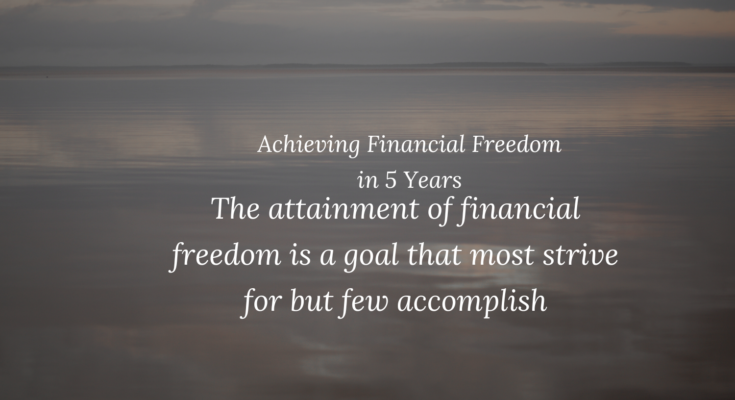Achieving Financial Freedom in 5 Years: A Practical Guide
The attainment of financial freedom is a goal that most strive for but few accomplish. It sometimes feels like a pot of gold at the end of the rainbow with lots of roadblocks—debt, rising expenses, and political strife making inroads into a fragile economy. However, it is both possible and realistic to achieve financial freedom within five years if you strategize wisely and commit yourself to the process. Thereby this article outlines the keystone steps that can lead you to financial independence in five years.
1:Assessing Your Current Financial State
The first step toward freedom is to know the state of your finances. You must take stock of your income, expenses, assets, and liabilities. This exercise involves coming to grips with your net worth, which is simply defined as the total of your assets, i.e. all savings, investments, and properties, minus the total of your liabilities, i.e. all debts and loans. It becomes a basic starting point to define where you are and what needs immediate work.
Be sure to account for every expense, ranking from fixed costs such as rent and utilities to discretionary spending such as dinner at Linas. This form of cognizance is vital since it allows you to see where you can cut back on expenditures and reallocate that sum towards wealth-building activities.
2:Set Clear and Measurable Goals
To be financially free within five years, it is crucial to have specific, measurable, and time-limited goals. Saying, “I want to be financially free” does not suffice. Break that overarching goals into smaller, actionable steps. For example:
Year 1: Pay off high-interest debt (credit cards, personal loans).
Year 2: Build an emergency fund covering 3–6 months of living expenses.
Year 3: Max out contributions to retirement accounts (401(k) or IRA).
Year 4: Start investing in real estate or stock to grow long-term wealth.
Year 5: Generate passive income sources that exceed monthly expenses.
By setting smaller goals, you maintain the forward momentum of achievement.
3:Pay Off Debt
High-interest debt like credit cards and personal loans is the greatest impediment to achieving financial freedom. The longer you hold a certain debt, the more you are likely to spend on interest payments, which will further worsen your saving and investment capacity.
A good strategy to tackle high-interest debts is the debt avalanche approach. If you have multiple debts, write them down in order of their interest rate and concentrate on paying off the one with the highest interest rate first, while making only minimum payments on the rest. After repaying the account with the highest interest, move on to the next debt on the list, and so forth. A counter-strategy is the debt snowball method, which focuses on clearing the smallest debt first to instill that sense of competition and motivation.
4:Live Within Your Means
It is expedient to attain financial freedom within your means. Simply put, this does not mean you stop going to that favorite weekend food spot; it involves making a conscientious allocation of all of your resources. The biggest racket of luxury lies in spending and investing in luxuries rather than focusing on savings and investments.
Some potential routes of reducing unnecessary spending include dining out, subscription services, and impulse buys. Direct that money to paying off debts, creating an emergency fund, or investing in income-generating assets. After all, the hard work will give the rewards of freedom, but disciplined living is part of this journey.
5:Start Investing and Diversify Your Portfolio
Investing is the solution if you wish to accumulate wealth over an extended duration. A traditional savings account will not serve you in beating inflation, interest rates that are way too low, and nothing in the dumps. To reap financial freedom, your money needs to work for you by investing in assets that appreciate over time.
You need to start with retirement savings accounts like a 401(k) or IRA, which give tax advantages to save for retirement.
6:Create Passive Income Streams
Passive income is money earned without direct active effort. This includes stock dividends, rental income from real estate, royalties from an intellectual property, or online business revenues. It is imperative that building passive income be considered for financial independence to reduce an individual’s reliance on a traditional 9-to-5 existence.
For the first few years of your journey toward financial independence, dedicate yourself to creating multiple streams of passive income. Perhaps you might invest in dividend stocks, or buy rental properties. Eventually, as those streams of income progress, you will decrease your working hours, allowing you to live on your investments.
7:Develop a Growth Mindset
A growth mindset is critical to achieving financial freedom. This involves constant learning and activity that develops your financial knowledge and skills. Attend personal finance programmes, read investment books, and stay tuned-in to economic developments. Such knowledge will enable you to make informed choices, avoid bad decisions, and gain on wealth-building opportunities.
Surround yourself with people who support the pursuit of financial independence. Sometimes having someone on the same path can provide priceless knowledge and insight, and motivate and hold you accountable.
Conclusion
Five years to attain financial freedom may feel a little unrealistic, but it can be achieved where there is dedication, discipline, and a strategic plan. By taking stock of your financial position, paying down debts, living within your means, clever investing, creating streams of passive income, and instilling a growth mentality, you are putting yourself on the right path towards achieving long-term financial independence. The journey to financial freedom will include hard work and, at times, sacrifice, but the rewards-life peace and the freedom to live on your own terms-are definitely worth the effort.

